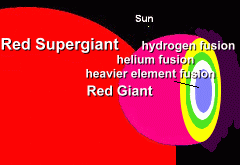|
Since about 1970, astronomers have been looking at the universe not just with ordinary telescopes, but with special devices that can see into space using all types of electromagnetic radiation, including radio, infrared, ultraviolet, X-ray, and gamma-ray light. One of their most amazing discoveries has been the 'black hole', a type of star which has some highly unusual properties. The existence of such unusual stars had been suggested in the early part of the twentieth century by the physicist Karl Schwarzschild, who used Einstein's general theory of relativity to predict the existence of ultra-dense objects with gravity so great that nothing could escape from them. Black holes are so dense that if anything should get closer that a certain distance, called the 'event horizon', it would not be able to escape. All material inside a black hole is crushed by gravity until it becomes a point of infinite density occupying virtually no space, called a singularity. Let's look more closely at what black holes are, where they come from, and what they look like. We'll even take you right inside one! Black holes come in all sizes, with a wide range of masses, but there are at really just two different types.
A star which is more than about ten times as massive as our sun will die spectacularly when it runs out of fuel. Its original supply of hydrogen has been converted to helium through nuclear fusion, and the helium has been converted to more massive elements, also through fusion. A massive star in its old age contains layers of hydrogen and helium inside it, each being consumed and transformed by nuclear fusion into other elements, and giving off energy. All of this is driven by the gravitational force of the massive star, which keeps the inner gases under immense temperature and pressure. The star is prevented from collapsing under its own weight by the intense radiation pushing outwards, given off by the elements as they fuse.  When these fuels inside the star begin to run out, however, the radiation pressure is no longer strong enough to keep the outer layers of the massive star from falling inwards under the pull of gravity. When that happens, the star begins to contract. When these fuels inside the star begin to run out, however, the radiation pressure is no longer strong enough to keep the outer layers of the massive star from falling inwards under the pull of gravity. When that happens, the star begins to contract. This immediately increases the temperature and pressure in the interior, until it is hot enough to ignite some of the heavier elements which were the products of previous nuclear fusion. These elements begin to fuse as well, releasing more energy, and swelling the star in size so that it becomes a red supergiant. Over and over, the star uses up each of the layers of elements in this way, continually fusing them into heavier ones, then contracting, and increasing its internal temperature and pressure each time. Eventually, however, an end is reached. Once the products inside include iron, no further nuclear fusion can take place, and the star has no further fuel source. The star is about to self-destruct! (These will be incorporated by newly forming stars in the neighbourhood. Indeed, all the elements on earth heavier than helium, including those that make up your body, were once made in a massive star, and spewed out in its eventual destruction). The picture at the right shows what's left of Eta Carinae, a massive star which exploded over 8000 years ago. At a distance of 8000 light years, we finally saw the explosion in 1850 AD. This is what it looks like 150 years after the supernova occurred. The intense pressure inside the supergiant causes the electrons in the iron core to be combined with the protons, forming neutrons. The whole core of the star becomes nothing but a dense ball of neutrons. It is possible that this core will remain intact after the supernova, and be called a neutron star. However, if the original star was very massive (10 or more times the mass of our Sun), even the neutrons will not be able to withstand the core collapse, and a black hole will form. A massive star that explodes with sufficient energy to compress even the neutrons in its core will cause the core to contract in on itself completely, creating a black hole. |